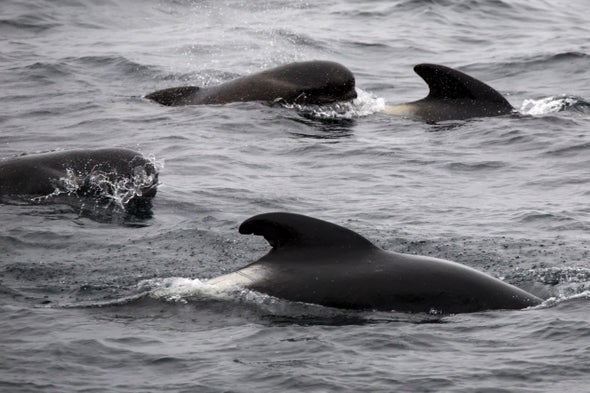Southern long-finned pilot whales are marine mammals with a lot to say—and they may use vocalizations to outsmart a deadly foe.
Cetaceans such as whales, dolphins and porpoises communicate through sound to find food and mates, to navigate and to interact socially. Their vocalizations vary between species and within communities. The animals can mimic artificial noise such as sonar, but nobody had previously recorded them matching other cetaceans' sounds. A new study, however, found overlap in the cetacean sound book.
Researchers listened to 2,028 vocalizations of long-finned pilot whales off the coast of Australia, the first time sounds from the species in this region have been comprehensively described. They were surprised to hear 19 instances of vocalizations that resembled those of orcas—the whales' oceanic rivals. “We found some calls that are, to the human ear, identical to the killer whale calls in the same area,” says Christine Erbe, director of the Center for Marine Science and Technology at Curtin University in Perth and co-author of the study, published in Scientific Reports.
Pilot whales and orcas, the two largest species of delphinid, are often seen in the same environments and are similar sizes, and both live in social groups with strong cohesion, says Charlotte Curé, a bioacoustics researcher at CEREMA Lab in France, who was not involved in the study. Orcas compete for food with long-finned pilot whales and are potentially their predators.
Evidence from orca stomachs shows they do occasionally eat pilot whales. But pilot whales can mob and chase orcas away, the only cetaceans seen defending themselves from the apex predator in this way.
Mimicry could serve as an additional defense: “One hypothesis is that if they use similar sounds, they may not be recognized as prey,” Erbe says. Pilot whales scavenging or eating orcas' food remnants might go unnoticed if they use orcalike calls. “This is all underwater, where light travels really poorly,” she adds. “So these animals rely on sound for detecting their prey and predators and for navigating.” Long-finned pilot whales have shown an ability to distinguish between orca calls with different meanings; Curé suggests that instead of tricking orcas, the callers could instead be demonstrating a new orca sound to other group members.
Additional work would confirm whether mimicry is actually occurring. Researchers could pair their listening data with direct observations of the animals' interactions in the wild or perhaps even play orca sounds and watch the whales' reactions.
But if a future experiment used predatory sounds, it would need to be done very carefully. “A reaction to a predator can be very strong,” Curé says. “In some protected areas, you are not allowed to do more than two predatory playbacks per year.”

